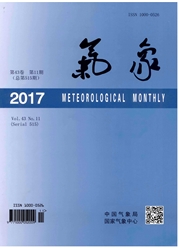

 中文摘要:
中文摘要:
等熵位涡分析是位涡理论的分析基础。此文的目的是介绍等熵位涡分析所必需掌握的基本概念和方法。文中从位温和位涡、对流层和平流层、锋和对流层顶的基本性质出发,讨论了锋和对流层顶在剖面图、等压面图及等位温面(即等熵面)图上的特征。文中给出了各种分析实例图形,并通过分析和对比指出:平流层的高位涡是对流层顶以上位温随高度急剧增加位温垂直梯度特别大的结果;位温垂直梯度是决定位涡分布的主要因子;等熵位涡图主要反映极地气团的活动,同时也是与极地气团密切关联的锋、急流、对流层顶的综合反映。最后提出了等熵位涡分析中需要避免的一些错误认识,特别是不能将等位温面上的流线当成轨迹的错误,并由此得出平流层空气侵入对流层下部的错误推论。
 英文摘要:
英文摘要:
The potential vorticity(PV) theory is based on the analysis methods of isentropic PV.This paper aimed at the introduction to the basic concepts and methods which are necessary to grasp to do the analysis of isentropic PV.It first gave the fundamentals of potential temperature and PV,troposphere and stratosphere,front and tropopause,and then discussed the characteristics of front and tropopause in the vertical cross sections,isobaric surface maps,and isentropic surface maps.Different kinds of chart instances were illustrated in this paper.Through analyses and comparisons,the results are obtained as follows. The high PV in stratosphere originates from the large vertical gradient of potential temperature which increases sharply with height above the tropopause.The vertical gradient of potential temperature is the main factor which determines PV distribution.The isentropic PV maps mainly reflect the activity of polar air mass,and the front,jet,and tropopause closely associated with polar air mass.In the end,this paper pointed out that some wrong knowledges should be avoided in the isentropic PV analyses,especially, we should avoid treating streamlines in the isentropic surface as trajectories and cannot obtain such a wrong deduction that the stratospheric dry air can intrude into the lower troposphere.
 同期刊论文项目
同期刊论文项目
 同项目期刊论文
同项目期刊论文
 期刊信息
期刊信息
